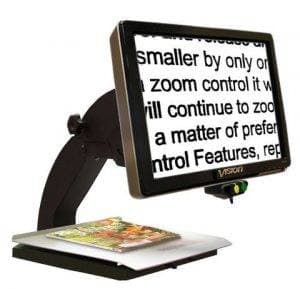Have you been told you or a loved one has low vision?
Low vision is diagnosed when vision cannot be fully corrected with glasses, contact lenses, or eye surgery— allowing you to participate in every day activities. It is often accompanied by blurred vision, blind spots or tunnel vision— and may also be called legal blindness.
Low vision may prevent you from driving, watching TV, reading, using a computer or participating in your favorite hobbies.
Low vision usually affects older adults, as it is generally caused by ocular diseases that are more common in older adults.
- 1 in 6 adults over age 45 has low vision.
- 1 in 4 adults over age 75 has low vision.
Low vision truly affects the lives of those who suffer from the condition.
Many people with low vision have difficulty with:
- Reading
- Driving
- Facial recognition
- Color vision
- Seeing the TV or computer screen clearly
Many people with low vision are unable to earn a living, or find it a constant struggle.
In 2010, only 37.2 percent of visually disabled Americans, ages 21-64, were included as part of the workforce.
Symptoms of low vision
Low vision may cause the following symptoms:
- Loss of central vision
- Loss of peripheral vision
- Night blindness
- Hazy vision
- Blurred vision
What causes low vision?
While low vision can be hereditary, or may be caused by an eye injury, the most common cause of low vision is ocular disease.
Poor vision that cannot be corrected with eyeglasses or contact lenses should be evaluated by an eye doctor to rule out the presence of ocular disease.
These are the most common eye diseases that cause low vision:
- Cataracts cause hazy, blurry vision.
- Macular degeneration causes blurred or partially obscured central vision.
- Diabetic retinopathy causes blind spots, blurriness and visual distortions.
- Glaucoma causes poor peripheral vision.
- Retinitis pigmentosa causes poor peripheral and night vision.
Increased light sensitivity and loss of color contrast can also result from these ocular diseases.
How is low vision diagnosed?
Low vision is diagnosed through a dilated eye exam. Your eye doctor will test your near, distant, central and peripheral vision. Your eye doctor will also dilate your pupils for a better view of the inner structures of your eyes.
A thorough examination of your eye health will enable detection of any signs of a condition that may lead to low vision.
If your low vision is making your day life challenging, contact an eye doctor near you, who can discuss the various options with you.
SEE RELATED: Understanding Low Vision
Living with low vision
Low vision can interfere with performance of daily activities, and diminish your quality of life. Unfortunately there is no treatment for low vision. However, many low vision devices have been created to help people with low vision regain their independence, and participate in the activities they once enjoyed.
What are low vision devices?
Low vision devices include any type of aid that functions to enhance vision clarity;
1 Head-mounted magnifiers
This type of low vision aid is useful for reading, writing, and other near vision tasks. This device offers increased magnification together with a specialized head piece to secure the lenses in front of your eyes.
2. Handheld magnifiers
This low vision aid is useful for on-the-go, as it’s small size is designed to fit comfortably in your hand.
This device offers multiple magnification strengths, and is easy to use. It is available in different sizes, weights, and features. The handheld magnifier can function as a traditional magnifying glass for reading a label on a bottle, or as an advanced electronic magnifier— which is more appropriate for extended use, such as when reading a book or magazine.
More advanced electronic handheld magnifiers often provide options for both handheld and surface resting modes. These advanced devices offer lighting and magnification adjustments for reading, the ability to capture an image or freeze the screen, and color/contrast settings.
Both traditional and electronic handheld magnifiers can provide excellent assistance for usage at home and on-the-go.
3. Portable desktop magnifiers
Portable desktop magnifiers provide assistance for tasks such as extended reading, computer usage, paperwork, office and school presentations, self-care, and more.
Portable desktop magnifiers contain a camera and viewing screen. The camera can be positioned according to varying situations, such as work environments and school— the camera can be directed at the images in the font of the room and displayed on the screen, magnified.
Additionally, this device offers the option to adjust magnification to as much as 82x, as well as color selection, and contrast settings. Another great feature is the mirror image display, which is ideal for shaving and makeup application.
4. Desktop magnifiers
Desktop magnifiers, also called closed circuit television or CCTV magnifiers, are stationary low vision aids. These devices provide higher levels of magnification power, viewing mode options, and other specialized features— makes these desktop low vision aids ideal devices for reading and other activities.
Most desktop magnifiers offer computer connectivity, and split screen capabilities. Some desktop magnifiers, such as the Merlin, offer a vertical viewing option if central vision is compromised or lost. They also provide peripheral reading and the ability to adjust the sharpness of an image.
More examples of low vision aids include:
- Bioptic telescopes
- Computer magnification
- Computer text-to-speech
- Large-face printed material
- Audio recordings
- Special light fixtures
- Signature guides for signing checks and documents
Special eyewear with tinted lenses and UV filters may also be recommended to reduce for light sensitivity and increase contrast.
LEARN MORE: Guide to Low Vision
If you are concerned about your vision, or you are experiencing visual changes, schedule an appointment with an eye doctor for a comprehensive eye exam.









